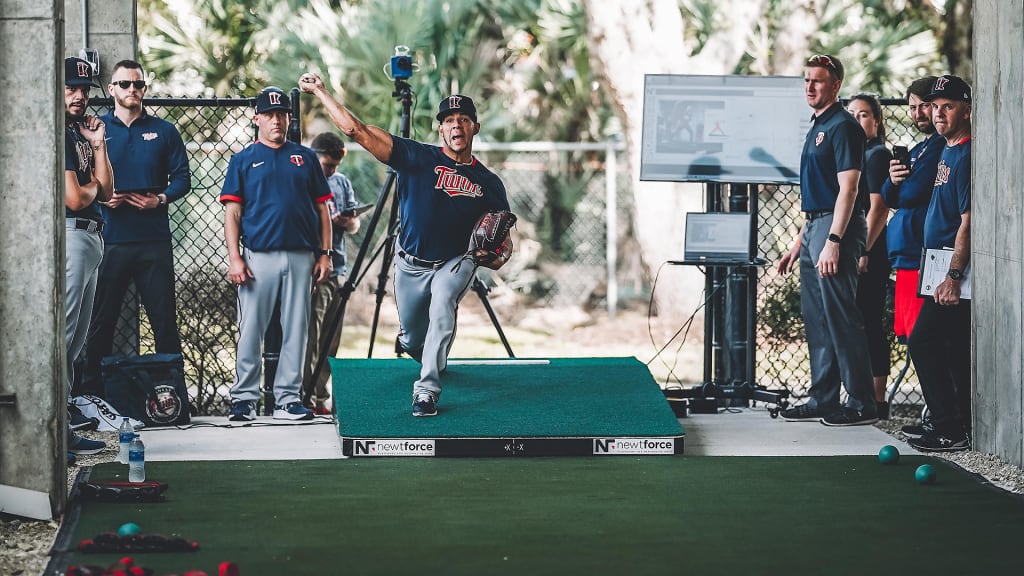
FORT MYERS, Fla. -- There are three bullpen mounds down the left-field line at Hammond Stadium. That's where, last spring, Twins coaches and analysts gathered around their Rapsodo machines and Edgertronic high-speed cameras to quantitatively analyze the pitchers in camp. All of that is still in place.
This year, though, there's one more hidden mound, tucked away in the left-field corner of the ballpark underneath the elevated walkway leading to the outfield seating sections. That's where the fun is happening.
The newest contraption in camp is a force-tracking mound from NewtForce, which allows pitchers to see the forces they exert on the ground through their motion and pair that information with video analysis of their delivery. The numbers can tell a story and identify possible inefficiencies and areas for improvement.
More importantly, Twins pitchers can see the difference with their own eyes.
"I started seeing [the difference] when they say, 'You did great,' or 'You didn't,'" José Berríos said. "I can't feel the difference, but that's going to help us as pitchers because that thing tells you how much you use your lower body."
The mound was actually the brainchild of Twins pitching coach Wes Johnson from his days at the University of Arkansas, and Florida Baseball Ranch proprietor Randy Sullivan deployed the technology at his facility to great success in a “beta testing” stage of sorts. That’s where Jake Odorizzi, among others, worked with it over the offseason before it was ready for full use at Twins camp.
"We weren't ready for it last year," Johnson said. "You can try to go too fast and people lose what we're doing with the advanced reports and what we're doing with Simi [motion tracking]. And then, as I was going into the thing with the mound, although we were getting the data, I needed the video to be with it. So when I created this thing back in 2017, we didn't have video with it. We just had graphs."
It's the kind of visual data analysis the Twins hope can spur continued improvement from their pitching staff, but especially from Berríos, who lowered his ERA for the third straight season to a career-best 3.68 in 2019 but still struggled at times with stamina and the consistency of his mechanics over a full season.
The system has already helped Berríos and the Twins identify and address an inconsistency in the right-hander's release point, which Johnson said led to some differentiation in his fastball, changeup and curveball releases. The Twins are trying to tighten up the extent to which Berríos rears back his right arm behind his back in his windup.
"There's a lot of things that the mound will tell us," Johnson said. "We saw it, obviously, last year. All throughout his career. The biggest thing is we didn't have a way to tell him -- I mean, we could tell him why, but we couldn't show him how or give him any objective feedback on it. Now, we're able to."
In an effort to address Berríos' durability, Johnson didn't necessarily scale back the workload of Berríos' notoriously aggressive offseason regimen, but placed an added emphasis on flexibility work on the hinging of Berríos' hips. That included additional work with weighted Plyo balls to re-emphasize certain movements.
Berríos eclipsed the 200-inning mark for the first time in his career in 2019 but again saw a dip in his performance in the second half (4.64 ERA) following a stellar first half (3.00 ERA). That continues a career-long trend, as Berríos owns a career 3.70 ERA before the All-Star break and a 4.84 mark afterwards.
"You look at [Berríos'] career, and he goes really good for a while, and then he takes [a dip], and it's a constant weighing with him," Johnson said. "We get there's going to be a slight dip and then a slight up. It's a long season. So our whole goal with not just him and with a lot of our guys is to close the gap of the wave."
The forward-thinking ways of Johnson and the front office have already paid dividends for the Twins' research and development capabilities. Perhaps this is the next step, and if so, the Twins' ace -- and others -- can reap the benefits.



